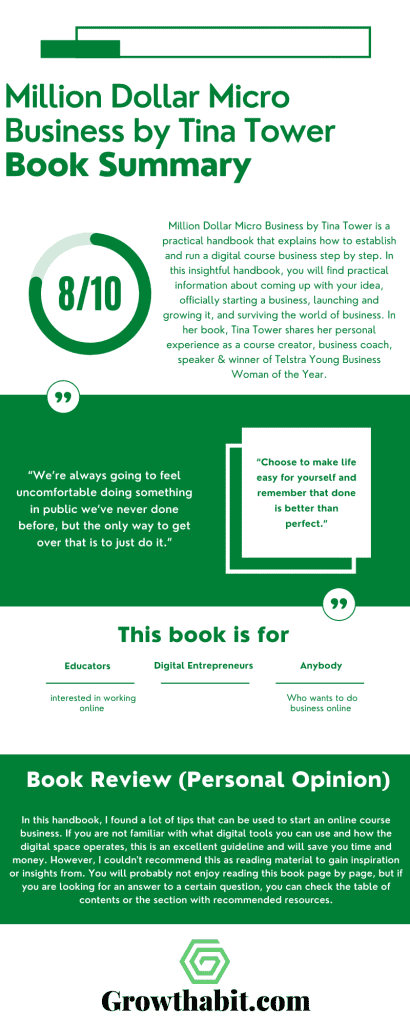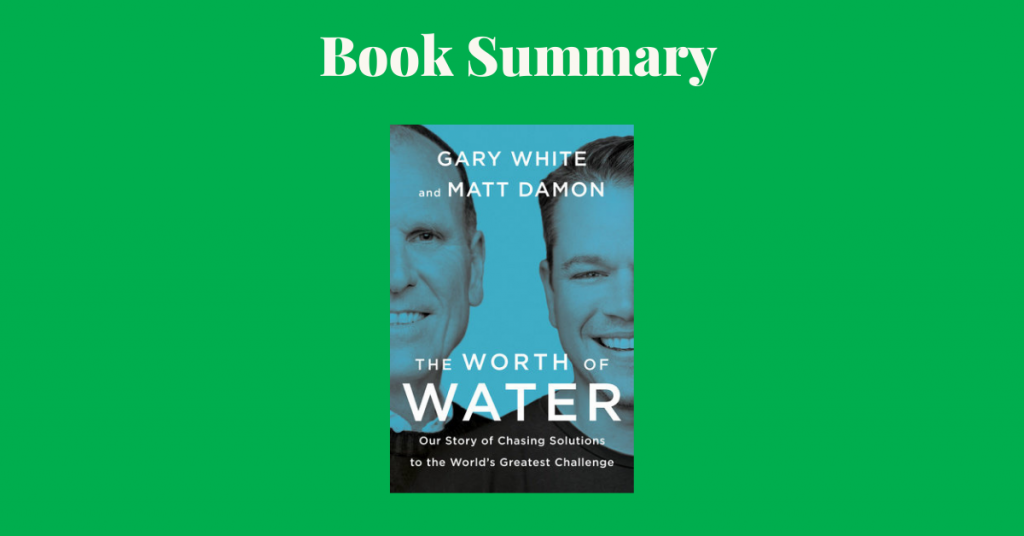The Worth of Water by Gary White and Matt Damon emphasizes the role of clean water and sanitation in ending poverty, creating economic opportunities, maintaining physical and mental vitality, and fighting inequality. It invites the readers to take an active part in recognizing people’s capabilities and encouraging initiatives that would elevate people in poverty and enable them to solve their own problems.
Book Title: The Worth of Water: Our Story of Chasing Solutions to the World’s Greatest Challenge
Authors: Gary White and Matt Damon
Date of Reading: April 2022
Rating: 8/10
What Is Being Said In Detail:
The Worth of Water presents a simple, yet powerful idea to help people who do not have easy access to safe water and sanitation by using impact investing and venture philanthropy.
What the Hell Is the “Water Issue”?
Chapter 1 cuts to the core of development issues, such as health, gender equality, education, environment, and economic prospects by tying them to one of the most fundamental issues – the lack of clean water and sanitation. This chapter reinforces the notion that “water is life.”
The Water Decade
Chapter 2 elaborates on the goal set by the UN General Assembly in 1980 to enable access to drinking water and sanitation for everyone in the world by the end of the decade. It elaborates on the struggles of people who do not have such access, as well as the necessity of including the local community in any sanitation projects.
The Big Idea
Chapter 3 reveals Gary White’s big idea to help people with limited access to clean water and sanitation solve their problems themselves. His idea was based on the true story of the foundation and the rise of Grameen Bank, which offered microloans to people, especially women, thus empowering them.
The Meet-Cute
Chapter 4 lays out the circumstances under which Matt Damon and Gary White met and started their professional relationship and collaboration pursuing lofty goals. This chapter elaborates on Gary White’s ‘Water Credit’ idea about giving poor people the chance to pay a reasonable price for a “reliable source of water and sanitation.”
Water.org Begins
Chapter 5 deals with people’s often mistaken perception of people in poverty. Instead of viewing them as helpless, we should recognize their potential for improvement, empower them, and encourage their initiatives. The chapter identifies a shift in the quality of life on a global scale.
The Big Idea, Take Two
Chapter 6 deals with the concept of impact investing that would ultimately result in a better world in which people who are currently poor will be given the opportunity to thrive and come closer to equality, resources, and prosperity.
The World Moves
Chapter 7 explores the positive and promising changes in the world caused by impact investing. It tackles two major issues: inequality and climate change by linking them to the issue of clean and safe water and sanitation. Moreover, it explores the benefits of blended finance.
Venture Philanthropy
Chapter 8 explains how venture philanthropy is impervious to whims and trends. The best ideas get funded and the money comes with ‘few strings attached.’ Venture philanthropy plays a key role in fighting inequality, preserving people’s health, and maintaining a safer world.
The Wave
Chapter 9 calls for action from anybody who wishes to invest in water and sanitation in order to contribute to making a positive change on a global scale. It invites the readers to take an active role in achieving this goal, even if they aren’t directly affected by the water crisis.
Most Important Keywords, Sentences, Quotes:
CHAPTER 1 – What the Hell Is the “Water Issue”?
“DATA introduced me to her because she was, in relative terms, a success story—a girl lucky enough to have a well close by so she could spend a good part of her days learning. Millions of girls aren’t so lucky. For them, getting water doesn’t take one hour; it takes three or four or six. It’s what they do: they walk for water.”
“Water is life.”
“For millions more children, waterborne diseases cause such severe malnourishment that their physical and mental growth is stunted forever.”
“Water is central to the fight to get more kids in school, too. Illnesses caused by waterborne diseases cause 443 million missed school days each year. The lack of bathrooms and sanitary products keeps girls at home for multiple days each month when they have their menstrual cycles. And of course, the long walks to water cause girls to drop out completely. If you want kids in the classroom, you have to end the water crisis.”
“And if you’re concerned about gender equity—what more significant step could we take to empower women and girls than simply to give them back their days?”
“The water crisis is also a big driver of extreme poverty, costing economies around the world $260 billion every year.”
“The one drink you get for free at any Starbucks, or any restaurant, is a glass of water. We’re used to drinking for free from fountains, or using free bathrooms.”
CHAPTER 2 – The Water Decade
“In the villages I’d visited, I met women whose entire lives, every minute of every day, were shaped by the fact that they didn’t have access to water and sanitation—from the moment they woke up (often at 4:00 a.m. so they could go to the bathroom in the fields while it was still dark, and therefore a little more private), to the daytime hours they spent collecting water, to the nights when they went to bed covered in grime because they had only enough water to wash their children.”
“In that moment in Guatemala City, I understood something that before I had only studied, had only known in the abstract: that for billions of people like this little girl, every day is a struggle to meet their most basic needs. For them, making sure that their families have water to drink and food to eat and a safe place to sleep takes so much of their energy that they have nothing left to invest in their own future.”
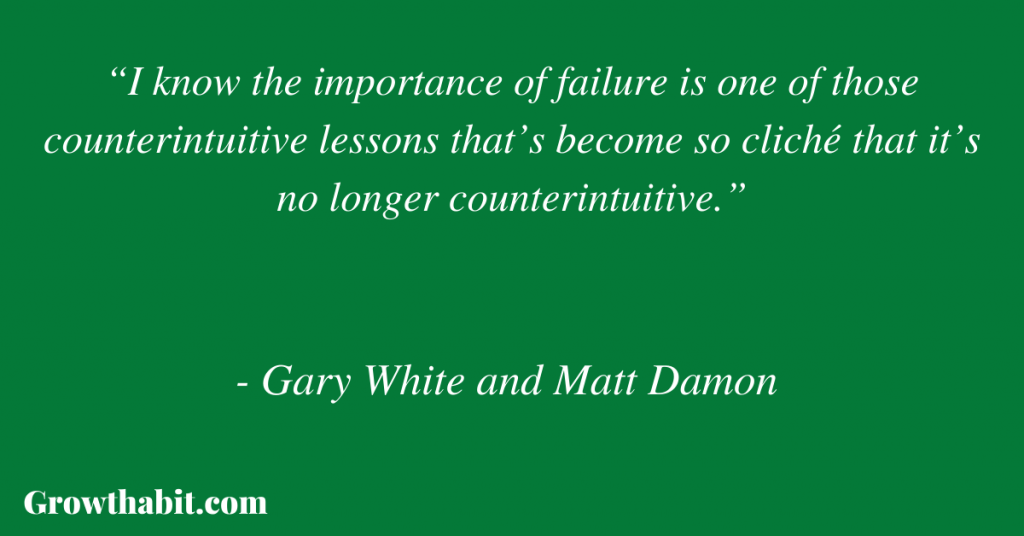
“As developing nations called attention to the crises they were facing, it became increasingly clear that healthy societies need clean, accessible water as urgently as our own bodies do. So, in 1980, the UN General Assembly set a goal that by the end of the decade, everyone everywhere would have access to safe water and sanitation.”
“As I visited villages across Latin America in dire need of clean water, I started to see something that, at first, made no sense at all: state-of-the-art wells, recently built, already broken down and abandoned. The core of the problem was that most of these water and sanitation projects weren’t being built with the local community. They were being built for the local community.”
“The well, by design, is going to be in constant use, and at some point, some part is going to break. And if that well has been installed by an American firm, using American-made parts— how is the local community going to fix it?”
“At the beginning of the Water Decade, there’d been a lot of talk about community engagement. However, truly engaging with the community, not just talking with people but really listening to them, takes work—especially if the project is being led by someone who lives in another country.”
“Whether we were drilling a well, constructing a piped system, or harvesting rainwater, we relied on hand pumps or gravity, rather than complicated electric pumps, to move the water. We used local materials and local workers so that when problems cropped up, they knew how to fix them.”
“I knew that getting easy access to water would transform these communities. But I was surprised to see that the process of constructing these water projects did, too.”
CHAPTER 3 – The Big Idea
“I kept thinking: people who worked in water and sanitation—me included—were seeing the suffering of people left to the loan sharks, as this woman had been, and assuming that what they needed was charity. So we, as a nonprofit, would go in and build them a solution. And frankly, we’d done an imperfect and agonizingly slow job of it.”
“This woman had shown me that she didn’t need to wait for someone to come in and solve her water and sanitation problems for her. What she needed was someone to invest in her so she could solve these problems herself.”
“People living in poverty pay absurd prices for water. In fact, they typically pay far more than what middle-class people who are connected to water utilities pay. And that’s true regardless of whether we’re talking about cities or rural areas, about regions that are water rich or water poor.”
“I’ve met people who are spending 20 percent of their income on water.”
“It’s expensive to be poor.”
“So people walk, stand, and wait all day—just to cope. They carry water for hours—to cope. They pay exorbitant rates for dirty water—to cope. They pay the resulting hospital bills—to cope. They pay ruinous interest rates to loan sharks—to cope.”
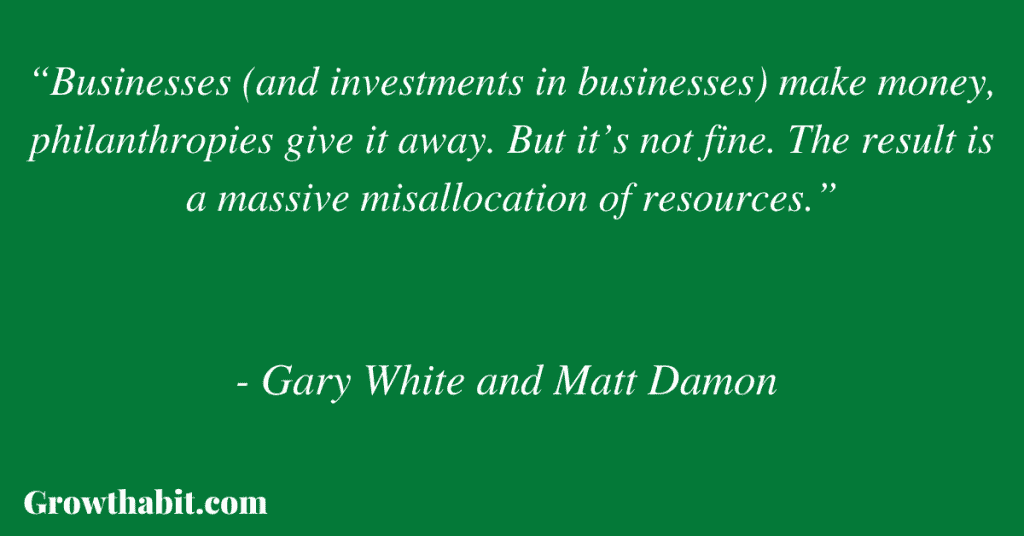
“If people in poverty could manage to get a small, fair loan, they could use it to fund more permanent solutions. And then they could take some of what they’d been spending on coping costs and use it instead to pay back the loan.”
“At the end of the day, we were paid back about fifty cents on the dollar. We learned that lending—especially in extremely poor places—is really tough business. You need for people to think of you as an entity that needs to be repaid, which was always going to be tough for an NGO.”
“Within twenty years, Grameen Bank had expanded to 40,000 villages in Bangladesh and given loans to 2.4 million borrowers—95 percent of them women. For many of these women, the act of taking out a loan was itself empowering.”
“Loans to poor people without any financial security had appeared to be an impossible idea. From modest beginnings three decades ago, Yunus has, first and foremost through Grameen Bank, developed micro-credit into an ever more important instrument in the struggle against poverty.”
“In slums, water and sewage pipes often run underneath the feet of people who simply aren’t connected to them. With a microloan, they can pay the connection fee and get taps and toilets connected to the city’s system.”
CHAPTER 4 – The Meet-Cute
“When Gary came in, he entered the ballroom on the opposite side, which meant we had to take a long, awkward walk to reach each other, grinning uncomfortably all the way. It had all the absurd drama of the meet-cute scenes you see in rom-coms, and I felt like I needed to break the tension. ‘Hey!’ I shouted. ‘Let’s talk water.’”
“I know the importance of failure is one of those counterintuitive lessons that’s become so cliché that it’s no longer counterintuitive.”
“Gary was billed as a water and sanitation engineer, but to me, he looked like an innovator—and exactly the kind of partner I’d been looking for.”
“But of course the thing that had Gary most excited wasn’t drilling wells. It was his new idea, WaterCredit. At that point, WaterCredit’s pilot programs in India were seeing promising results, and there was the potential for much greater success ahead.”
“As he explained, there were hundreds of millions of people around the world who, despite their very low incomes, were able to pay a reasonable price for water and sanitation, and who, incredibly, were eager to pay for a reliable source of water and sanitation—if only they were given the chance.”
CHAPTER 5 – Water.org Begins
“In any event, it was clear to me, clear to everyone in the room, that Matt brought a passion to these issues that was very deeply felt.”
“For all the progress we’d made, it had been a continual challenge to persuade people to care about the water crisis when, as Matt wrote earlier, they’d never been forced to imagine what it would be like to go without water.”
“And before Matt and I could create a true partnership, we would have to make sure our colleagues saw our vision, too. Depending on your perspective and your degree of confidence in the other party, a merger can look like a sharing of strengths, or it can look like a sacrifice of identity and autonomy. Raising the idea with our respective organizations was like introducing two families before a marriage takes place, and both are a little skeptical about the union that’s being proposed.”
“In time our professional families, as families often do, came around and embraced our union. Not reluctantly, but enthusiastically.”
“The problem comes, to my mind, when we look at people in poverty only as subjects of charity. When all we hear about people in poverty is that they need our help—when all we hear about the problems in their lives is that we need to step in and solve them—we’re conditioned to see them as this mass of people who are powerless in the face of daunting challenges. Looking at them that way obscures their diversity—and blinds us to their power.”

“As I heard more and more stories like this, I saw that no matter where you are in the world, people have a fundamental drive to improve their lives. To build something better. I kept hearing people describe the plans they had for their families, all the sacrifices and investments they were making to improve their futures.”
“This was part of a larger global shift. So many families had been lifting themselves out of poverty since I started this work in the 1980s that they were changing the world around them. I could see the change clearly because I’d spent decades visiting low-income countries.”
“We want people in wealthy nations to stop talking about struggling communities as if they are helpless—as if their only chance at a better future is through our sympathy and charity. We want everyone to see their potential; respect their strength, ambition, and initiative; and help them harness their power.”
CHAPTER 6 – The Big Idea, Take Two
“Our trips to the communities where WaterCredit was working were full of joy. We’d talk to women who’d taken out water and sanitation loans and learn what they were doing with the extra hours in their days. We’d visit schools and sing along with the kids.”
“Every time we met with an MFI on that trip, we asked the same question: “What’s the biggest obstacle in your way right now?” Almost word for word, they all gave the same answer: ‘Consistent access to affordable capital.’”
“The MFIs were trying to lift people up, not bury them in debt. So if they couldn’t get their interest rates lower soon, most of them would stop making new loans.”
“The whole reason Gary and I had been so excited about WaterCredit— and the whole reason we’d felt bold enough to talk about ending the crisis for good—was that we thought we could get to a point where these loans would be available to everyone who needed one.”
“The money that people (as well as corporate philanthropies) donated to Water.org had no such expectation attached. The whole idea of philanthropic giving is that it’s, well, giving. You give it away to help improve people’s lives and never expect to get it back. But why couldn’t we ask people and organizations to contribute differently to our work?
What about asking some of them not to give the money away, but to invest it, and to get a modest return on that investment?”
“The divide between giving and investing seemed to many like an apples and oranges thing, and in our naïveté, we were trying to pitch people on, I don’t know, an apple-orange.”
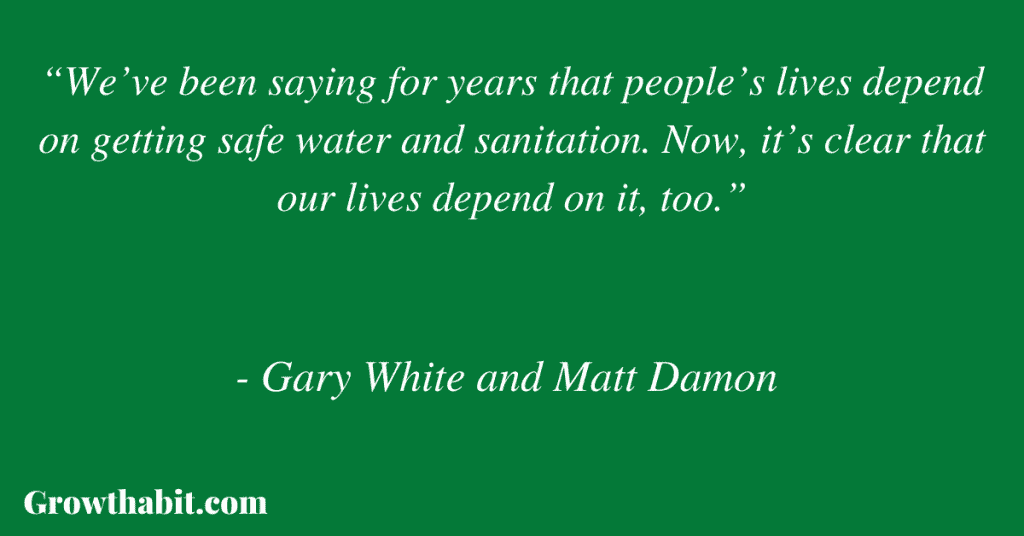
“Businesses (and investments in businesses) make money, philanthropies give it away. But it’s not fine. The result is a massive misallocation of resources.”
“But it ought to be possible to care about your own well-being and the world’s future at the same time.”
“But what if you could get a decent return while putting your money to work toward creating a better, fairer, safer world?”
CHAPTER 7 – The World Moves
“We also had plenty of evidence that our model worked, and now we had the teams in place to keep scaling it up. And like non-native speakers who immerse themselves in a culture, Matt and I were learning the language and starting to feel our fluency in talking about finance.”
“By 2016, two formidable challenges were keeping the capitalists (and almost everybody else, for that matter) awake at night. The first was climate change: scientists’ warnings were becoming more and more dire. And the second was inequality—the stark reality that the global economic system was working only for the lucky few, leaving people at the base of the pyramid struggling to meet their most basic needs.”
“But it’s one thing to be aware of a problem, another to do something about it, and a whole other thing to transform the way you think and do business in order to do something about it. That takes time.”
“For a long time, inequality and climate change had been the two big elephants in every room. It took work to ignore them—and believe me, some businesses worked pretty hard. But by the mid-2010s, it was not only harder to do that, it had become more obviously self-defeating.”
“As the conversation in the business world changed, it no longer seemed so radical to consider the impact an investment was going to make on the world, not just on the investor’s portfolio.”
“There was another consequence, too, of the focus on inequality and climate change: people got more interested in water. A lack of clean water is about as stark an example of inequality as you can find, and water issues are central to the climate crisis, too. Though when it comes to climate, things get complicated.”
“With blended finance, you bring together a wide range of investors— from those with a low tolerance for risk to others with a high tolerance, from people expecting no return to people expecting a near market-rate return—and pool their resources together in the same fund.”
CHAPTER 8 – Venture Philanthropy
“It turned out the issue was one that lots of other NGOs and social enterprises had faced at some point in their life cycle: the whims of philanthropy. It sounds crazy—it is crazy!—but philanthropy, like fashion, like music, has vogues. One minute you’re in, then something new comes along . . . and if you’re not quite out, well, you’re not as in as you used to be.”
“We should have remembered the Water Decade and its unceremonious end. Maybe we just thought that things were different this time.”
“What they talked about was money—or the lack of it. Like Water.org, nearly all of them were having a hard time getting funding. Here were leaders of social enterprises with incredibly high potential to succeed, yet many of them were having trouble keeping the lights on.”
“I mention all this because experts pretty much agree that the three factors you see in that scene—destruction of natural habitats, which brings wild animals into proximity with humans; industrial agriculture, which weakens animals’ immune systems; and globalization, which puts all humans in closer contact with one another—create the conditions for new diseases to spread.”
“Universal water and sanitation access will make pandemics less likely to begin in the first place—and slower to spread if they do.”
“We’ve been saying for years that people’s lives depend on getting safe water and sanitation. Now, it’s clear that our lives depend on it, too.”
“Laguna Water has shown us the way: fix your infrastructure, waste less water, waste less energy. Others are designing smarter water and sanitation systems, which run on less energy and reduce the pollution from wastewater at the same time.”
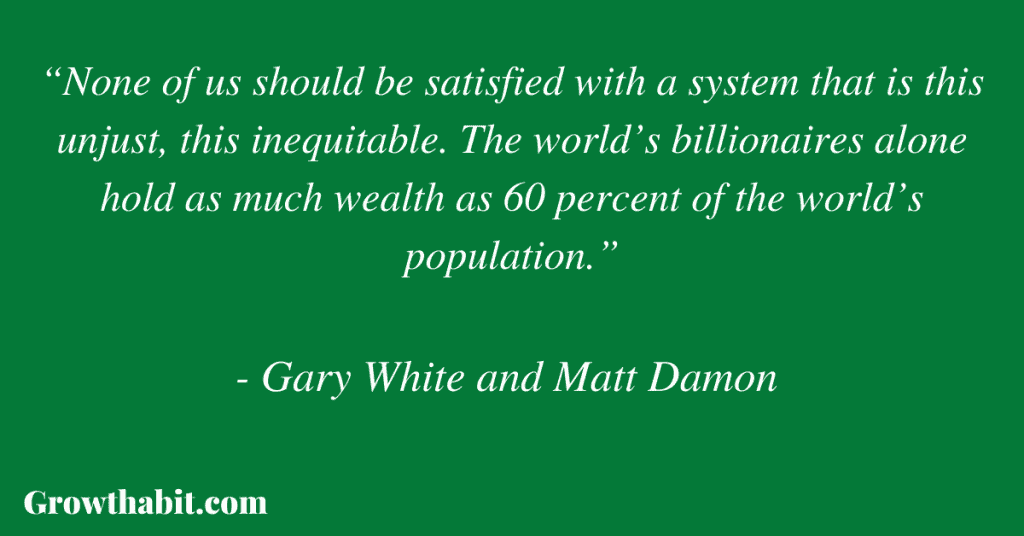
“Venture philanthropy, as Rockefeller defined it, doesn’t follow the whims of donors or the trends of the moment. Instead, it’s distributed more like venture capital: funding goes to the most promising ideas that need capital in order to fulfill their promise. It comes with few strings attached because progress depends on taking risks. And as an idea succeeds, its funding grows—allowing it to scale to the point where “changing the world” isn’t just hype.”
“None of us should be satisfied with a system that is this unjust, this inequitable. The world’s billionaires alone hold as much wealth as 60 percent of the world’s population.”
CHAPTER 9 – The Wave
“To end the crisis, we need a wave.”
“We’ve started to focus on the next group that lacks access to water and sanitation: people for whom microloans alone aren’t going to be enough. That’s because where this group lives, something essential is missing: infrastructure. In parts of many cities, and especially in the perimeter just outside urban areas, there are no pipes carrying water under the streets; there is no sewage system; there’s nothing to tap into.”
“In order for any of this to happen, though, we need you. The person reading this book. Maybe it’s strange to start addressing you directly, now—like you’re watching a musical, and it’s the very last song, and suddenly they start doing audience participation. But the fact is that this movement can’t be powered only by the people who are affected by the crisis.”
Book Review (Personal Opinion):
I felt overwhelmed after reading this book because the living conditions of people who have restricted access to clean water have been described in detail. I was left with a sense of hope for a better tomorrow in the end, so I would recommend it to anyone who is concerned with environmental, health, and social issues.
Rating: 8/10
This Book Is For:
- Leaders of organizations
- Philanthropists
- CEOs of companies
- Anybody who would like to make the world fairer and safer
If You Want To Learn More
Here’s an interview with Gary White and Matt Damon in which they discuss the true worth of water:
The View
How I’ve Implemented The Ideas From The Book
I’ve become more mindful when it comes to saving water at home.
One Small Actionable Step You Can Do
Take short showers.
